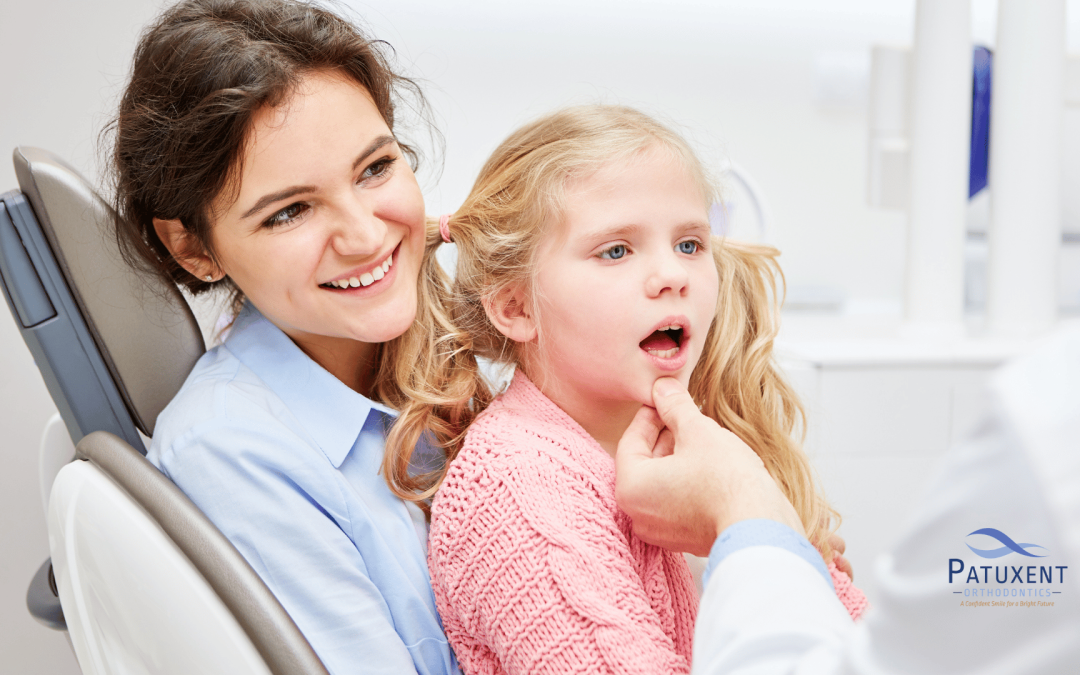- What is an Orthodontic Headgear?
- What are the Different Types of Orthodontic Headgear?
- What are the Benefits of Orthodontic Headgear?
- What Conditions Does Orthodontic Headgear Help Address?
- What are the Side Effects of Wearing Orthodontic Headgear?
- What to Avoid When Wearing Orthodontic Headgear
- Patuxent Orthodontics is Ready to Help You With Your Orthodontic Treatment!
- References
Jack has always been curious about the world of orthodontics. He’s been hearing a lot about braces and clear aligners, but he’s still got one question on his mind: Do people still use that funky orthodontic headgear? Jack’s seen it in old movies and TV shows, but he’s unsure whether it’s still a thing nowadays or just a source of nightmares for kids with poor dental health. Join Jack as he dives into the world of orthodontics and finds out if headgear treatment is still making its mark on patients’ smiles!
What is an Orthodontic Headgear?
Orthodontic headgear is a dental appliance patients sometimes wear to help correct issues with their teeth or jaws. It’s like a special brace attached to your teeth, with straps going around your head or neck. Orthodontists use headgear when the teeth or jaw need extra help to get into the right position. There are different types of headgear, and the kind you need depends on your specific issue. Some headgear helps with an overbite or underbite, while others help with crooked teeth or narrow jaws. Wearing headgear initially feels strange and might not look super cool, but following your orthodontist’s instructions is essential to get the best results. After all, the goal is to have a healthy and beautiful smile at the end of your treatment!
What are the Different Types of Orthodontic Headgear?
A few different types of orthodontic headgear can help address tooth and jaw issues.
Cervical Headgear Appliance
This type corrects an overbite (i.e., when your upper front teeth stick out too far in front of your lower teeth). Cervical pull headgear has a part that attaches to your upper back teeth, and a strap goes around the back of your neck. The gentle pulling action from the neck strap helps move your upper teeth back into the right position.
High-Pull Headgear
If you have an overbite and your upper jaw is also growing too much vertically, you might need high-pull headgear. Like cervical headgear, it attaches to your upper back teeth but with a strap going up and over your head. This setup helps control both the forward and upward growth of your upper jaw.
Reverse-Pull Headgear
This one’s for underbites (i.e., when your lower teeth are in front of your upper ones). The reverse-pull headgear, also called a facemask, has pads that rest on your forehead and chin. It uses elastics connected to your braces to gently pull your upper jaw forward so it lines up better with your lower jaw.
J-Hook Headgear
This headgear type is similar to cervical headgear but with J-shaped hooks attached to the braces. It’s often used to move your upper or lower teeth back. J-Hook headgear effectively addresses various dental issues like overbites, underbites, or protruding teeth.
Palatal Expander With Headgear
Sometimes, a narrow upper jaw is the issue, for which you need to make more room. A palatal expander is a device that fits in the roof of your mouth and slowly widens your jaw. Some expanders come with headgear to give them extra support and help control the direction of the expansion.
What are the Benefits of Orthodontic Headgear?
Orthodontic headgear might not be the coolest fashion accessory, but it’s got some awesome benefits for your teeth and jaws:
Better Smile
One of the main reasons people wear headgear is to improve the appearance of their teeth. Once your treatment is done, you’ll be able to show off that fabulous smile you’ve been dreaming of!
Easier Chomping
When your teeth and jaws are in the right position, it’s way easier to bite, chew, and enjoy your favorite foods. No more struggling with that crunchy apple or chewy pizza crust!
Clearer Speech
Sometimes, wonky teeth and jaws can make it hard to pronounce certain words or sounds. With headgear doing its thing, you might find that speaking becomes clearer and more natural!
Healthier Teeth and Gums
It’s easier to keep your teeth clean and healthy when properly aligned. That means fewer cavities, less gum disease, and a happier mouth overall!
Better Jaw Function
Headgear can help correct issues with your jaw, like overbites and underbites. This means less strain on your jaw muscles and joints, helping prevent pain and other issues down the line.
Improved Self-Confidence
Let’s be honest, having a great smile can do wonders for your confidence. Once your headgear has done its job, you’ll be able to flash your pearly whites with pride!
What Conditions Does Orthodontic Headgear Help Address?
Orthodontic headgear helps address a variety of dental and jaw-related conditions!
One common issue it tackles is an overbite, where the upper teeth protrude too far in front of the lower teeth. It can also correct underbites, where the lower teeth are positioned in front of the upper ones. Headgear is effective in fixing these issues by gently applying pressure to move the teeth and jaw bones into their proper positions.
Another condition orthodontic headgear can address is a narrow upper jaw. In this case, a palatal expander with headgear is used to gradually widen the jaw, creating more space for teeth and improving the bite. Headgear can also help manage issues related to the position of individual teeth, such as teeth that are too far forward or backward, by working in conjunction with braces.
Additionally, orthodontic headgear aids in controlling the growth and development of the upper and lower jaw, especially in growing children and adolescents. By guiding the jaws into proper alignment, headgear improves not only the appearance of the teeth and smile but also the overall oral health, chewing function, and speech clarity!
What are the Side Effects of Wearing Orthodontic Headgear?
Wearing orthodontic headgear can definitely take some getting used to, and there might be a few side effects along the way. Don’t worry, though — most of the discomfort is pretty normal and manageable:
Discomfort
When you first start wearing headgear, you might feel some pressure, soreness, or even a bit of pain in your teeth, jaws, and face. This is normal because your teeth and jaws adjust to the new forces. The discomfort should ease up after a few days, but if it’s really annoying you, over-the-counter pain relievers can help.
Trouble Sleeping
Sleeping with headgear will be weird initially, and finding a comfortable position might take some time. Try using a soft pillow or cushion to support your head and neck, and be patient — you’ll get used to it eventually!
Irritation
Your headgear’s straps and metal parts might rub against your skin, causing redness and irritation. If this happens, you can put some orthodontic wax, silicone, or soft cloth on the parts that bother you. If the irritation gets bad, though, let your orthodontist know.
Difficulty Speaking and Eating
Talking and eating when wearing headgear might be tricky, especially at first. You’ll likely need time to adapt, but don’t worry — most people figure it out quickly. Just take it slow, and remember that practice makes perfect!
Feeling Self-Conscious
Let’s face it, headgear isn’t exactly a fashion statement. As a result, you may feel self-conscious wearing it, especially in public. But keep in mind that it’s temporary, and the result will be a fantastic smile. Plus, you’re not alone — lots of people have to wear headgear at some point in their lives!
What to Avoid When Wearing Orthodontic Headgear
There are a few things you should avoid when wearing orthodontic headgear to make sure everything goes smoothly and your treatment works as it should:
- Skipping wear time. Your orthodontist will tell you how many hours a day you need to wear your headgear. Sticking to that schedule is essential, even if it’s a bit annoying. The more you wear it, the faster your teeth and jaw will get to where they need to be!
- Eating hard or sticky foods. Chowing down on hard, sticky foods will damage your headgear or braces. Steer clear of caramels, gum, popcorn, hard candy, and crunchy snacks. Instead, stick to soft foods that are easier on your gear.
- Playing rough sports. If you’re into contact sports or activities with a higher risk of facial injuries, removing your headgear while playing is best. Talk to your orthodontist about getting a mouthguard to protect your teeth and braces during sports.
- Ignoring your oral hygiene. Keeping your teeth clean is always important, but it’s even more important while wearing your headgear. Ensure you brush and floss regularly to avoid cavities, gum disease, and other dental issues.
- Not speaking up about issues. Don’t just suffer in silence if something feels off or you’re experiencing pain or discomfort that won’t go away! Reach out to your orthodontist and let them know what’s going on. They can help adjust your headgear or advise you on dealing with any issues!
- Fiddling with your headgear. It might be tempting to play with the straps or the parts that connect to your braces, but resist the urge. Messing with your headgear can damage it, slow down your treatment, or even cause injury!
Patuxent Orthodontics is Ready to Help You With Your Orthodontic Treatment!
Contact Patuxent Orthodontics if orthodontic care is the way to achieve the beautiful smile of your dreams! Whether you want to learn more about the benefits of our orthodontic services or simply have questions about the process, use our live chat or call (240) 802-7217 or send us a message through our contact us page to connect with our friendly staff today and book a free consultation! Our office, located at 44220 Airport View Dr., Hollywood, MD 20636, proudly serves Maryland’s Patuxent area, as well as the Greater Washington DC area. So, if you’re residing in California, Lexington Park, and Great Mills and are looking for one of the best orthodontists in MD, don’t hesitate to visit our office! We also invite you to keep up with our blog to get answers to many of the frequently asked questions about maintaining sparkling oral health and follow us on Facebook and Instagram to become a part of our smiling community!
References
- Whelan, Corey. “What Is Orthodontic Headgear and How Does It Help Straighten Teeth?” Healthline, Healthline Media, 13 Sept. 2019, www.healthline.com/health/dental-and-oral-health/headgear#what-its-like. Accessed 1 May 2023.
- “3 Types of Orthodontic Headgear & Conditions They Fix.” NewMouth, 2023, www.newmouth.com/orthodontics/treatment/headgear/. Accessed 1 May 2023.
- “Guide to Headgear Braces: Pros, Cons, Alternatives.” NWPH Dental Health, 6 Jan. 2022, www.nwph.net/headgear-braces. Accessed 1 May 2023.














